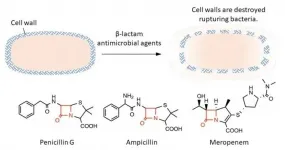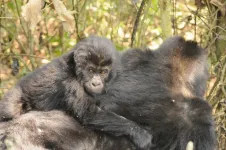(Press-News.org) BOSTON - In the three months since Johnson & Johnson's COVID-19 vaccine received emergency use authorization from the U.S. Food and Drug Administration, more than 10 million Americans have received the vaccine, according to the Centers for Disease Control and Prevention. The single-shot viral vector vaccine -- developed in collaboration with Beth Israel Deaconess Medical Center (BIDMC) immunologist Dan Barouch, MD, PhD -- was authorized for use based on clinical trial data showing strong clinical efficacy against symptomatic COVID-19 in the United States, Latin America and South Africa.
In a new study published in Nature, Barouch, Director of BIDMC's Center for Virology and Vaccine Research, and colleagues report on the antibody and cellular immune responses generated by the Ad26.COV2.S vaccine against the original viral strain and against SARS-CoV-2 variants of concern. The team found that this vaccine induced immune responses against all the viral variants.
"The concern is whether SARS-CoV-2 variants may reduce the efficacy of current vaccines that were designed to protect against the original SARS-CoV-2 strain at the beginning of the pandemic," said Barouch, senior author of the study and also Professor of Medicine at Harvard Medical School. "These findings therefore have important implications for vaccine protection against SARS-CoV-2 variants of concern."
To explore the immunogenicity of Ad26.COV2.S, Barouch and colleagues at BIDMC administered one or two doses of Johnson & Johnson's investigational vaccine to 20 volunteers between the ages of 18 and 55. All volunteers were participants of a larger multicenter, randomized, double-blind, placebo-controlled Phase 1/2a study to evaluate the vaccine at various doses and schedules. The researchers then used multiple methods to assess antibody and cellular immune responses against the original viral strain (WA1/2020) and against the viral variants first identified in South Africa (B.1.1351), the United Kingdom (B.1.1.7), Brazil (P.1) and California (CAL.20C).
Compared to antibody responses against WA1/2020, the data showed reductions in neutralizing antibodies against the B.1.1351 and P.1 strains. In contrast, non-neutralizing antibody responses and T cell responses were minimally impacted or not impacted by SARS-CoV-2 variants. Given the vaccine's protective efficacy as demonstrated in Phase 3 clinical trials, non-neutralizing antibodies and/or T cell responses may contribute to protection against COVID-19.
The published Phase 3 efficacy data showed that the Ad26.COV2.S vaccine offered strong protection against symptomatic COVID-19 in South Africa and in Brazil where most sequenced COVID-19 cases were caused by variants. The findings contribute to our understanding of vaccine protection against SARS-CoV-2 variants of concern.
"Although the mechanistic correlates of protection for COVID-19 are not yet known, the vaccine's robust protective efficacy in these regions raises the possibility that non-neutralizing antibodies and/or T cell responses may also
contribute to protection," said Barouch, who is also a member of the Ragon Institute of MGH, MIT, and Harvard. "Alternatively, it is possible that low levels of neutralizing antibodies are sufficient for protection against COVID-19."
INFORMATION:
Co-authors included Galit Alter of the Ragon Institute of MGH, MIT, and Harvard; Jingyou Yu, Jinyan Liu, Abishek Chandrashekar, Erica N. Borducchi, Lisa H. Tostanoski, Katherine McMahan, Catherine Jacob-Dolan, Aiquan Chang, Tochi Anioke, Michelle Lifton, Joseph Nkolola and Kathryn E Stephenson of BIDMC; Caroline Atyeo, Sally Shin of the Ragon Institute of MGH, MIT and Harvard; David R. Martinez, Ralph S. Baric of University of North Caroline at Chapel Hill; Paul Fields, Ian Kaplan and Harlan Robins of Adaptive Biotechnologies; Fatima Amanat and Florian Krammer of Icahn School of Medicine at Mount Sinai; Mathieu Le Gars, Jerald Sadoff, Anne Marit de Groot, Dirk Heerwegh, Frank Struyf, Macaya Douoguih, Johan van Hoof and Hanneke Schuitemaker of Janssen.
This work was supported in part by Janssen Vaccines & Prevention, BV; the Ragon institute of MGH, MIT and Harvard; the Massachusetts Consortium on Pathogen Readiness (MassCPR); the Musk Foundation; the National Institutes of Health (grants CA260476, AI007151, AI 152296): the Boroughs Wellcome Fund Postdoctoral Enrichment Program Award; a Hannah H. Gray Fellowship from the Howard Hughes Medical Institute; federal funds from the Office of the Assistant Secretary for Preparedness Response, Biomedical Advanced Research and Development Authority under other transaction agreement HHS01002017 00018C.
Dr. Barouch is a co-inventor on related vaccine patents. Please see the publication for a complete list of competing interests.
About Beth Israel Deaconess Medical Center
Beth Israel Deaconess Medical Center is a patient care, teaching and research affiliate of Harvard Medical School and consistently ranks as a national leader among independent hospitals in National Institutes of Health funding. BIDMC is the official hospital of the Boston Red Sox. For more information, visit http://www.bidmc.org.
Beth Israel Deaconess Medical Center is a part of Beth Israel Lahey Health, a health care system that brings together academic medical centers and teaching hospitals, community and specialty hospitals, more than 4,000 physicians and 35,000 employees in a shared mission to expand access to great care and advance the science and practice of medicine through groundbreaking research and education.
A joint research project based in Kumamoto University, Japan has developed a new, highly sensitive analytical method that can detect degraded β-lactam antibacterial agents used in the treatment of bacterial infections. With this method, researchers found that reactive sulfur species produced by bacteria degrade and inactivate β-lactam antibiotics.
Bacteria are different from animal cells in that their outer layer is covered with a rigid structure called a cell wall. β-lactam antimicrobial agents interfere with the processes that form the cell wall. This results in bacteria no longer being able to withstand their own internal pressure so they rupture and die. β-lactam antimicrobial agents are very potent ...
For nearly half a century, astrophysicists and organic chemists have been on the hunt for the origins of C6H6, the benzene ring - an elegant, hexagonal molecule comprised of 6 carbon and 6 hydrogen atoms.
Astrophysicists say that the benzene ring could be the fundamental building block of polycylic aromatic hydrocarbons or PAHs, the most basic materials formed from the explosion of dying, carbon-rich stars. That swirling mass of matter would eventually give shape to the earliest forms of carbon - precursors to molecules some scientists say are connected to ...
New research shows transmission of the virus behind COVID-19 varies seasonally, but warmer conditions are not enough to prevent transmission.
The study, led by Imperial College London researchers and published today in Proceedings of the National Academy of Sciences, is the first to incorporate environmental data into epidemiological models of the transmission of SARS-CoV-2, the virus behind COVID-19.
The team show that temperature and population density are the most important factors determining how easily the virus spreads, but only in the absence of mobility-restricting measures, such as lockdowns.
First author of the study Dr Tom Smith, from the Department of Life Sciences at Imperial, said: "Our results ...
KINSHASA, Democratic Republic of Congo (June 9, 2021) - A new study led by the Wildlife Conservation Society (WCS) has updated the global population estimate for the Critically Endangered Grauer's gorillas (Gorilla beringei graueri) - the world's largest gorilla subspecies- to 6,800 individuals from a previous global estimate of 3,800 individuals. This revised estimate comes from recent field surveys conducted in one of this animal's largest remaining strongholds, in areas that were previously inaccessible for surveys. However, these gorillas continue to be heavily impacted by ongoing insecurity, and by human incursion into their remaining habitat in eastern Democratic Republic of Congo.
Publishing in the American Journal of Primatology, ...
Researchers at Vanderbilt University Medical Center (VUMC) have identified a common mechanism underlying a spectrum of epilepsy syndromes and neurodevelopmental disorders, including autism, that are caused by variations in a gene encoding a vital transporter protein in the brain.
Their findings, reported last month in the journal Brain, suggest that boosting transporter function via genetic or pharmacological means could be beneficial in treating brain disorders linked to these genetic variations.
"This points (to) a clear direction of treating a wide spectrum of neurodevelopmental disorders, from various epilepsy syndromes (and) autism to neurodevelopmental delay and intellectual ...
June 9, 2021 - The first analysis of medical evidence on domestic mass shooters in the U.S. finds that a large majority of perpetrators have psychiatric disorders for which they have received no medication or other treatment, reports a study in the Journal of Clinical Psychopharmacology. The journal is published in the Lippincott portfolio by Wolters Kluwer.
"Without losing sight of the larger perspective that most who are violent are not mentally ill, and most of the mentally ill are not violent, our message is that mental health providers, lawyers, and the public should be made aware that some unmedicated patients do pose an increased risk of violence," according to the report by Ira D. Glick, MD, of Stanford University School of Medicine and colleagues.
In-depth analysis of ...
Smithsonian Conservation Biology Institute scientists are one step closer to understanding why some corals can weather climate change better than others, and the secret could be in a specific protein that produces a natural sunscreen. As their name implies, Hawaiian blue rice corals sport a deep blue pigment, which is created by chromoprotein and filters out harmful ultraviolet (UV) radiation from the sun. Although UV damage may produce long-term impacts to reproduction in many coral species--including brown rice coral--it may not have the same effect on blue rice coral. The findings of this study were published June 9 in ...
From 1980 to 2016, grain production in Brazil increased more than fourfold, and the country now stands as the world's largest soybean exporter and the second largest exporter of corn. The two main drivers of this increase in food production were cropland expansion and double-cropping, harvesting two crops, such as corn and soybeans, from the same field in a single year.
While cropland expansion has long been recognized as one of the drivers behind the increase in Brazil's agricultural output, a new study published in Nature Food quantifies for the first time the impact that double-cropping also ...
The fairy circles of the Namib are one of nature's greatest mysteries. Millions of these circular barren patches extend over vast areas along the margins of the desert in Namibia. In 1979, G.K. Theron published the first research about their origin. His hypothesis was that poisonous substances from Euphorbia damarana leaves induced fairy circles. As part of a new study, scientists from the University of Göttingen and the Gobabeb Namib Research Institute located the original euphorbia plants that were part of Theron's study. Four decades later, the researchers are now able to conclusively disprove Theron's original hypothesis. Their results were published in the journal BMC Ecology and Evolution.
In the late 1970s, South African botanist Theron noticed ...
A University of Oklahoma doctoral student, graduate and undergraduate research assistants, and an associate professor in the Homer L. Dodge Department of Physics and Astronomy in the University of Oklahoma College of Arts and Sciences are lead authors on a paper describing a "changing-look" blazar - a powerful active galactic nucleus powered by supermassive blackhole at the center of a galaxy. The paper is published in The Astrophysical Journal.
Hora D. Mishra, a Ph.D. student, and faculty member Xinyu Dai are lead authors of the paper, along with Christopher Kochanek and Kris Stanek at the Ohio State University and Ben Shappee at the University of Hawaii. The paper represents the findings of researchers from 12 different institutions who participated ...







